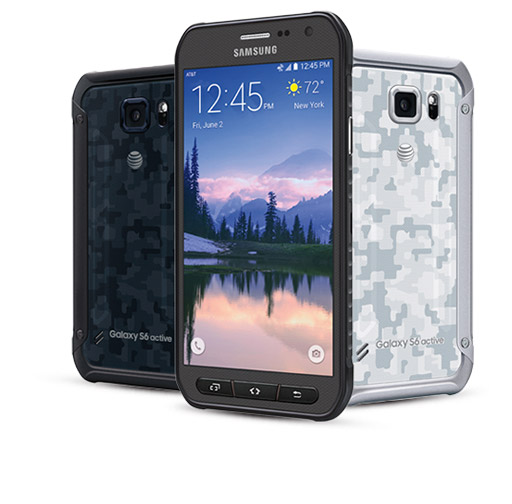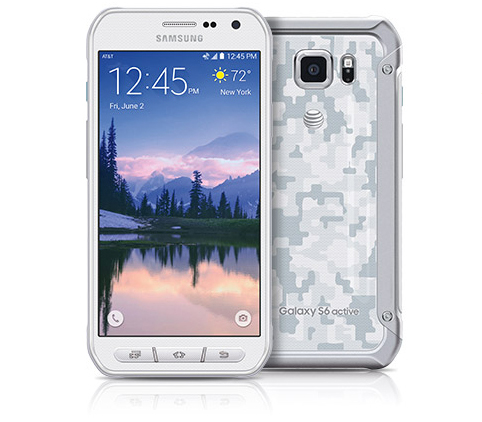Samsung Announces The Galaxy S6 Active
by Brandon Chester on June 8, 2015 11:18 AM EST- Posted in
- Smartphones
- Samsung
- AT&T
- Mobile
- Galaxy S6 Active

Today Samsung and AT&T announced the Galaxy S6 Active, a variant of the Galaxy S6 with a greater focus on durability and ruggedness. Releasing an Active version of their flagship Galaxy device has become a tradition for Samsung since the Galaxy S4, and it looks like this year is no exception. While it differs in its construction and design, I think people will find that its specifications are quite familiar. I've organized its specifications in the table below.
| Samsung Galaxy S6 Active | ||||||
| SoC | Exynos 7420 2.1/1.5GHz A57/A53 | |||||
| Memory and Storage | 3GB LPDDR4-1552, 32GB NAND | |||||
| Display | 5.1" 2560x1440 AMOLED | |||||
| Cellular Connectivity | 2G / 3G / 4G LTE (Category 6 LTE) | |||||
| Dimensions | ? | |||||
| Cameras |
16MP (5132 x 2988) Rear Facing 5MP Front Facing |
|||||
| Battery | 3500 mAh (13.48Wh) | |||||
| Other Connectivity | 2x2 802.11a/b/g/n/ac + BT 4.1, USB2.0, GPS/GNSS, NFC | |||||
| Operating System | Android 5.0.2 Lollipop + Touchwiz | |||||
| SIM | NanoSIM | |||||
As far as its specifications go, the Galaxy S6 Active is effectively the same device as the normal Galaxy S6. It has the same 5.1" 2560x1440 AMOLED display, the same Exynos 7420 SoC, the same cameras, and the same connectivity. Where it differs are its dimensions, and subsequently, its battery capacity. While Samsung hasn't disclosed the size and mass of the Galaxy S6 Active, it's safe to say based on the photos that the rugged build makes it a larger device than the normal Galaxy S6. However, the larger size and greater thickness have allowed for a substantial increase in battery capacity. While the normal Galaxy S6 ships with a 9.81Wh battery and the S6 Edge with a 10.01Wh battery, the Galaxy S6 Active has a whopping 13.48Wh battery.
The biggest difference from the original Galaxy S6 with the Galaxy S6 Active is its design. The glass back of the Galaxy S6 is gone, and the entire device is surrounded by an additional frame to protect from damage. The single home button and capacitive keys have been replaced by three hardware buttons as well. It also appears that the fingerprint sensor has been removed in order to accommodate the hardware buttons.
As a rugged device for an active lifestyle, the Galaxy S6 Active wouldn't be complete without resistance to water and dust. Its chassis has an IP68 rating for dust and water resistance, which guarantees protection when submerged in water as deep as 1.5 meters for up to 30 minutes. The Galaxy S6 Active also meets the Mil-STD-810G standard for resistance to pressure, temperature, humidity, shocks and vibrations.
AT&T lists the Galaxy S6 Active as "Coming Soon", and customers will be able to purchase it on June 12. It will be available in camo white, camo blue, and grey finishes. On AT&T Next the Galaxy S6 Active will cost $0 up front, with a $695 cost split into monthly payments for a 20, 24, or 30 month term.
Source: AT&T











25 Comments
View All Comments
danbob999 - Monday, June 8, 2015 - link
What about temperature?I can't believe they still make phones which are not rated to operate below 0C. "Active" must not include any winter sport.
spectralsarah - Monday, June 8, 2015 - link
"...meets the Mil-STD-810G standard for resistance to pressure, temperature, humidity, shocks and vibrations."K_Space - Monday, June 8, 2015 - link
Mil-STD-810G includes 502.5 which tests for low temperature.There are three cold test environments:Basic Cold covers most of Europe; Northern contiguous US; Coastal Canada (up to -31C). Cold covers Canada, Alaska (excluding the interior); Greenland (excluding the “cold pole”); Northern Scandinavia; Northern Asia (some areas). Severe Cold covers the Interior of Alaska; Yukon (Canada); Interior of Northern Islands; Greenland ice cap; Northern Asia and specifies a single temperature of -51 deg C. http://www.chassis-plans.com/blog/mil-std-810g-par...
RaichuPls - Monday, June 8, 2015 - link
Isn't IP68 rated for full water protection? Since IPx7 is rated for 30 minutes in 1 meter of water, IPx8 should be in 3 meters of water infinitely right?frenchy_2001 - Monday, June 8, 2015 - link
You would be correct.According to wikipedia, the first digit is dust resistance and the second water:
http://en.wikipedia.org/wiki/IP_Code
Dust level 6 is "Dust tight",
Water level 8 is continuous immersion up to 3m.
So, ATT seems to be contradicting themselves here...
shadarlo - Monday, June 8, 2015 - link
This is the only version of the S6 I'd consider... and it's a VERY appealing option. The main things I care about in a phone are a long life battery, water/shock resistance, tap on/off (G4 likely will get my vote for this feature alone), and a good camera.Every mid to high end phone can text/run basic apps and web blazingly fast now. It's the little things that matter more imo.
Impulses - Monday, June 8, 2015 - link
Agreed, I care more about ergonomics and peripheral stuff at this point than performance or even things like display quality. Camera doesn't even make the list for me since I have nicer cameras I use much more often...Battery life, wireless charging, weather resistance, and even things like the ability to customize it (leather or different color backs, Moto Maker, etc) ALL matter more to me.
Outside of battery life tho, those things can be pretty subjective and not everyone will care about ALL of them. I think the market could benefit from more focused models rather than almost arbitrary high end vs mid range vs w/e disparities tho.
At least this Active has flagship specs so it doesn't make any sacrifices... Unlike previous ones.
Impulses - Monday, June 8, 2015 - link
Is there actually an outdoor/military usage case that calls for three physical buttons in situations where capacitive wouldn't work? I mean, it's not like you can get much done with just home/back/app switch and no touch, tho I guess it could potentially make quick searches easier (only need one button for that tho).Intuitively you would think physical buttons would actually make LESS sense on a rugged model, one more thing that can break down and one more body gap to seal, yet a lot of rugged phones have these. Just trying to figure out the logic here... Or is it just Samsung holding steadfast to their buttons like some sorta design identity?
0xDeadbeef - Monday, June 8, 2015 - link
You are right Impulses, those buttons create an additional point of failure on the phone. However, they allow you to answer/make calls in the case the digitizer (screen) gets broken. The buttons are (well, at least should be) on a separate circuit that offers an additional layer of fallback in both aftershock and high/low temperature conditions that make touch screen interaction quite impossible (people in the North Pole don't wear "touch screen gloves" typically. Additionally, you don't require visual contact to answer or hang up, this is also very important under many circumstances not seen by the common consumer. And let's forget the "voice" assistant, noise is usually part of the equation.These phones are rarely chosen by their owners but rather decided at a higher "level" (I am typically one of those people who has to decide which phone a large number of other people will be equipped with while on research expeditions).
Sx Active models are historically nice and tough but not excellent. The S6 Active is a joke: no sdcard port and no removable battery feels like it was designed by Silicon Valley nerds rather than by people who actually work in the outs. I wouldn't stand a chance showing this to my management and I'd probably get fired. Well, it gives you the idea :)
Impulses - Monday, June 8, 2015 - link
Um, how do your answer/make calls with the home/back/app switcher buttons? Is there a special setting in TouchWiz that lets you enable answering calls with those buttons?Plus if that's the sole benefit, why not just map the to the volume down button or something like that? It's not like you could get much more done with a button than the single usage case you mentioned.
Still doesn't seem to make any sense to me...